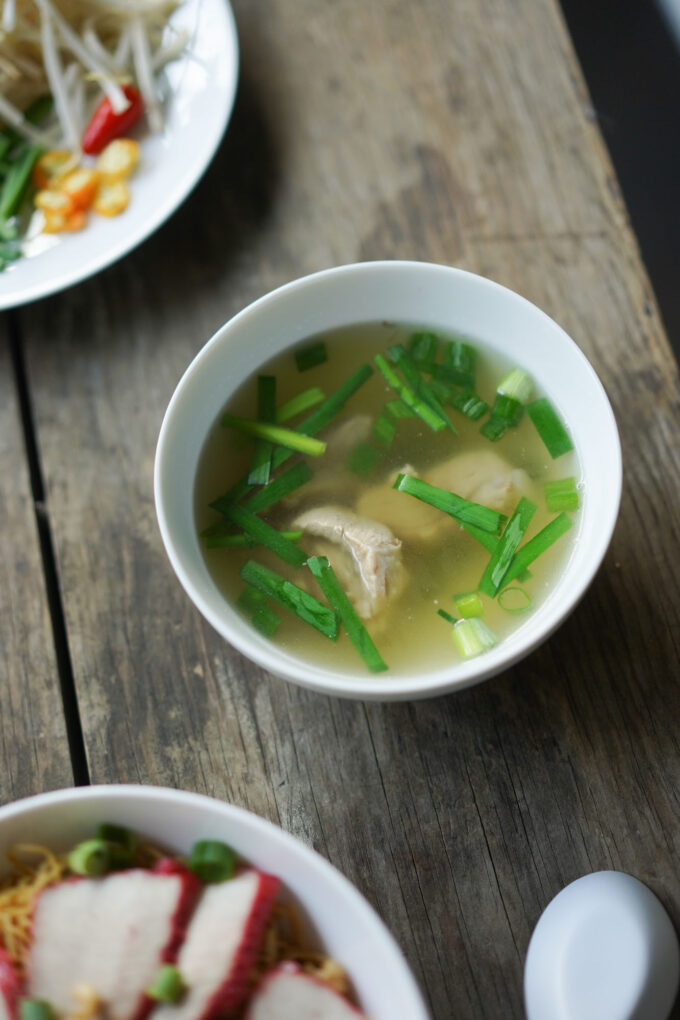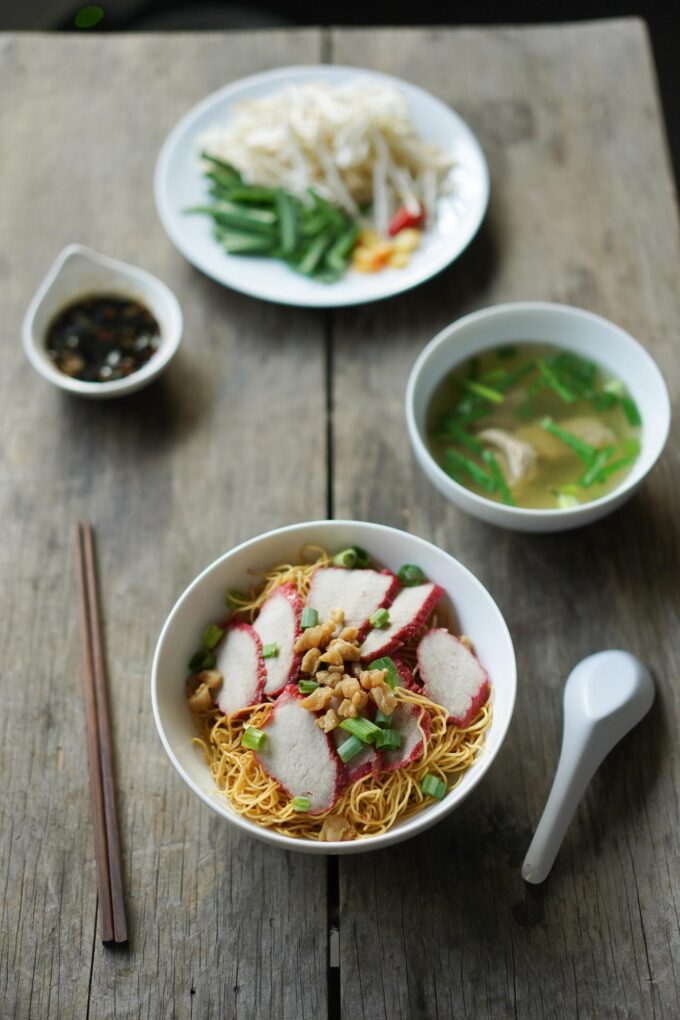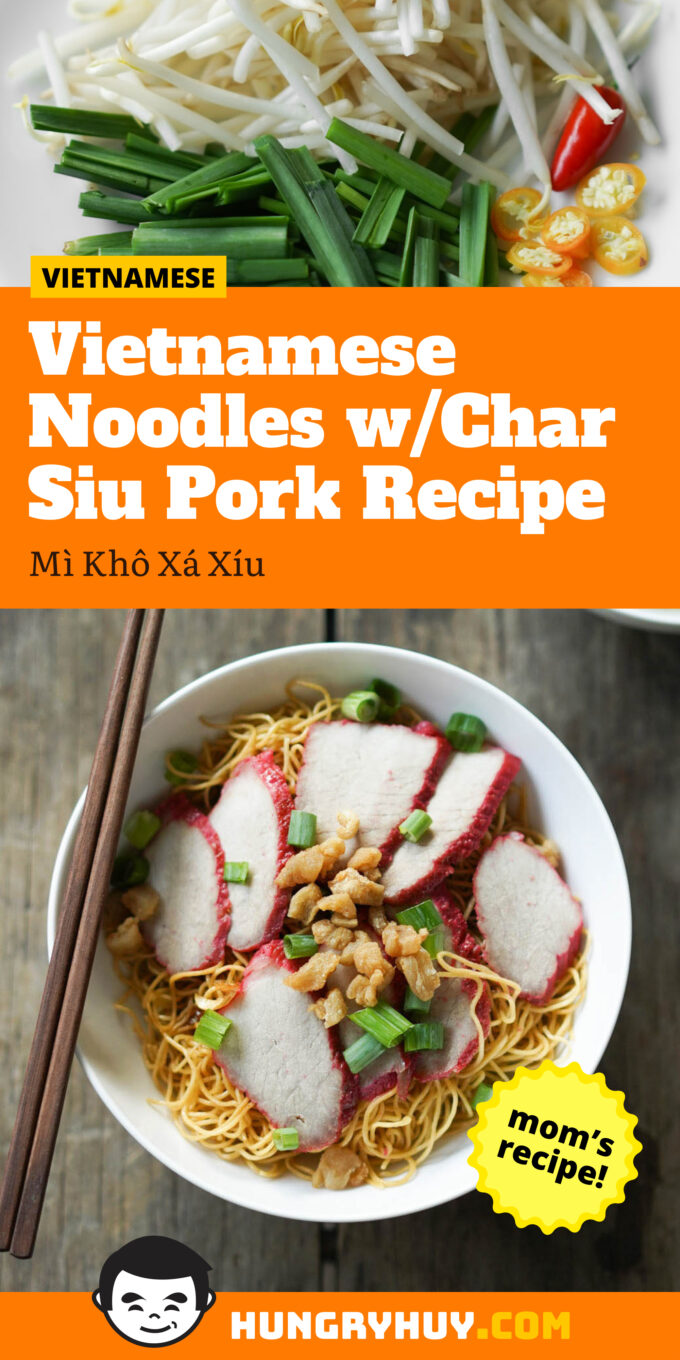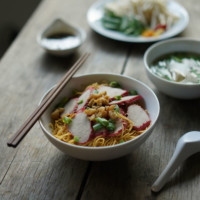This mì khô recipe, aka dry egg noodles, is one of those amazing comfort foods that somehow just always hits the spot.
The bulk of the bowl is egg noodles with a concentrated seasoning (that you don’t get in the soupy version!), flavor infused xa xiu/char siu pork, fresh scallions, crisp bean sprouts, a side of hot soup broth with chives and pork spare ribs, and of course topped with crispy fried pork fat (tep mo).
It’s easily mistaken for something super simple [yet delicious], but when you make these noodles, you’ll realize how many layers of flavors and textures go into making it. This is an incredible noodle bowl and totally worth the effort!

I used to eat these noodles with my parents all the time when I lived with them, at a place downtown. After 20 something years I went back and the same guy was still running the place!
All restaurants that serve this these egg noodles serve it soupy or with soup on the side and is usually a smallish, no-frills joint, which I’m definitely ok with. As long as the food is good, and no frills means a lower food bill I can live with that!

This is also perfect for me since even in other soups like pho or bun bo hue, as amazing as the broths can be, I’m not about to drink the whole bowl of liquid (there would be no room left for coffee or dessert).
So a tiny bowl of heavily chived soup on the side is perfect. Take a few bites of seasoned and spicyish noodles, take a little hot soup sip break, and repeat.

For toppings or variations on these noodles, the place I now frequent in Southern California offers roasted duck (yum!), shrimp, banh xep (like a battered and fried shrimp thing), seafood, or combo options.
I prefer the simple, and flavorful xa xiu option just about everything, and that’s what we’re making in this recipe! It’s extremely similar to the recipe I already have up for xa xiu for Vietnamese sandwiches, except you don’t use belly, and you don’t need to tie or roll it up before cooking.

Ahh what would any Vietnamese dish or soup be without a heaping pile of veggies? I prefer my bean sprouts and chives blanched a bit. It softens both, and takes away a bit of the chive’s bite.

This photo is actually incomplete. The bowl of noodles is NOT ready to eat until I add a splash of vinegar, a squirt of spicy Chinese style mustard, and a few spoonfuls of broth to the noodles.
I can’t speak to authenticity of this, but it’s basically what I’ve been taught over the decades by my family. It is a DIY, scale to your own liking type of thing so feel free to try it out!
The local restaurant I frequent serves these green peppers soaked in vinegar. Basically light pickled. But I like to take em out and let it swim in soy sauce for a few minutes before taking itty bites out of them.
Lots of little details to sort out, but where’s the fun without the fuss? I LOVE mì khô and hope you do after trying this out too. Drop a comment below once ya try and let me know what you think.
How do you eat Vietnamese dry noodles?
Deconstructed Vietnamese noodles that come with an additional bowl of broth are fun to eat and great for those who don’t like to eat too much of the soup or like to keep their noodles dry. There are various ways to eat dry noodles: using a soup spoon to add some broth into your bowl or adding some broth into your soup spoon and using chopsticks to add some noodles on top and taking a mouthful.
I like to add a splash of vinegar and spicy Chinese-style mustard to it too, and eat with soy sauce soaked pickled jalapenos too. I also love eating this dish with some youtiao on the side for an extra crunchy texture.


Mì Khô Xá Xíu (Vietnamese Dry Noodles with Char Xiu Pork)
Ingredients
- 2 lb thin egg noodles
Xa Xiu (Char Siu Pork)
- 2 lb pork shoulder
- 1 cup filtered water
- 2 Tbsp cooking wine
- 2 Tbsp light soy sauce
- 2 tsp garlic powder
- 2 tsp onion powder
- 1/2 tsp salt
- 1/2 bag Char siu / Chinese barbecue seasoning
Broth Prep
- 2-3 lb pork bones or pork spare ribs (I like half of each)
- 2 Tbsp salt
- tap water
Broth
- 14 cups filtered water
- 2 medium onions peeled, and left whole
- 2 Tbsp dry squid or dry shrimp toasted 3 min, then rinsed until clean
- 2 Tbsp salt
- 2 Tbsp sugar
- 1 tsp MSG (monosodium glutamate)
Noodle Seasoning
- 2 Tbsp neutral cooking oil
- 1 Tbsp minced garlic
- 4 Tbsp oyster sauce
- 4 Tbsp soy sauce
- 2 Tbsp Chinese cooking wine
- 2 Tbsp sugar
- 2 Tbsp rice vinegar
- 8 Tbsp water
Tep Mo (fried pork fat)
- 1/2 lb raw pork fat for tep mo
Accoutrement
- 1 lb bean sprouts blanched
- 2 bunches chives cut into 2" pieces
- rice vinegar to taste
- spicy Chinese mustard to taste
Instructions
Xa Xiu
- Add all ingredients into a pan. Heat on high until boiling, then lower to medium high and cook for ~15 minutes while flipping the pork every ~5 minutes. Turn heat to medium-low and continue rotating the pork every ~5 minutes so it cooks and abosrbs the seasoning evenly, until just about all the water has evaporated.
Broth
- Add all pork bones or pork ribs to a pot and fill with tap water until just covered. Add 2 Tbsp salt and bring to a boil on high heat. Once it hits a boil, let it boil for 30 seconds and then turn off the heat, and drain. Rinse under running water until clean and drain the water.
- Return the pot to the stove and add all the broth ingredients. Turn the heat to high until it hits a boil, then lower to around medium so it maintains a low boil. Cook until the meat or meat around the bones is soft–approximately 2 hours.
- Remove the lid, discard the onion and squid, then check the pork for doneness if using pork meat and not just bones.
Tep mo (fried pork fat)
- Cut the pork fat into 1/2" cubes and saute on medium high heat until crisp, drain and set aside.
Noodle Seasoning
- Add oil and shallot to a small sauce pan and saute on medium until fragrant. Add the remainint ingredients and bring to a boil on high. Taste, and adjust as needed, then remove from heat.
Noodles & Assembly
- Boil noodles according to package instructions, drain and split into 8 bowls. Assemble your bowl with accoutrement, sliced xa xiu, fried pork fat and add a bit of seasoning on top of each bowl. Serve with a small bowl of soup on the side.










Hello,
Long time lurker here 🙂
Can’t wait to try this recipe. This is how I like mi xa xiu, kho-style. My local noodle shop makes the best and also with the vinegar-jalapenos on the side too! But their broth is incredible. Going to try out this recipe this weekend. Thank you for posting it!
Glad to finally put out a post that got you to comment Annie :). Let me know how it goes!
I like your recipes and the instructions are very easy to follow. I use to live in a large city that Vietnamese restaurants were accessible but now living in a small area that does not have good restaurants. I can make sure my cooking is close to home as possible with your help. It’s interesting that you use Chinese hot mustard in the soup. I have seen it on the table at the restaurants but did not think it was part of Vietnamese cuisine. What else do you use it with?
Thanks for the comment Kim :). I actually don’t use that mustard much at all, only for this recipe. In a pinch the Japanese kind would probably work too–we just need something with that nostril tickling spice.
Thanks for all the recipes! Moved away from home last year and whenever I miss my mom’s cooking, I can be pretty sure that you’ll have a recipe for it and that way I can try and make it myself.
Also funny enough, my parents and I had a place in downtown San Jose that we’ve been going to for years that serves this and it’s awesome. May have to try this one day when I have a lot of time on my hands!
Thanks for dropping a comment! Yeah I don’t know if many spots dt served it so I wonder if we were ever there at the same time 🙂